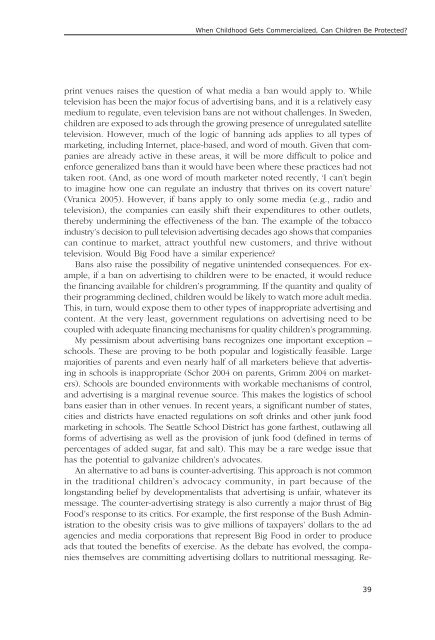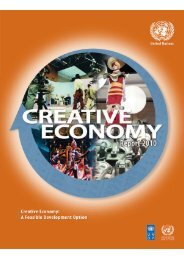In the Service of Young People? Studies and Reflections on Media ...
In the Service of Young People? Studies and Reflections on Media ...
In the Service of Young People? Studies and Reflections on Media ...
- No tags were found...
You also want an ePaper? Increase the reach of your titles
YUMPU automatically turns print PDFs into web optimized ePapers that Google loves.
When Childhood Gets Commercialized, Can Children Be Protected?print venues raises <str<strong>on</strong>g>the</str<strong>on</strong>g> questi<strong>on</strong> <str<strong>on</strong>g>of</str<strong>on</strong>g> what media a ban would apply to. Whiletelevisi<strong>on</strong> has been <str<strong>on</strong>g>the</str<strong>on</strong>g> major focus <str<strong>on</strong>g>of</str<strong>on</strong>g> advertising bans, <str<strong>on</strong>g>and</str<strong>on</strong>g> it is a relatively easymedium to regulate, even televisi<strong>on</strong> bans are not without challenges. <str<strong>on</strong>g>In</str<strong>on</strong>g> Sweden,children are exposed to ads through <str<strong>on</strong>g>the</str<strong>on</strong>g> growing presence <str<strong>on</strong>g>of</str<strong>on</strong>g> unregulated satellitetelevisi<strong>on</strong>. However, much <str<strong>on</strong>g>of</str<strong>on</strong>g> <str<strong>on</strong>g>the</str<strong>on</strong>g> logic <str<strong>on</strong>g>of</str<strong>on</strong>g> banning ads applies to all types <str<strong>on</strong>g>of</str<strong>on</strong>g>marketing, including <str<strong>on</strong>g>In</str<strong>on</strong>g>ternet, place-based, <str<strong>on</strong>g>and</str<strong>on</strong>g> word <str<strong>on</strong>g>of</str<strong>on</strong>g> mouth. Given that companiesare already active in <str<strong>on</strong>g>the</str<strong>on</strong>g>se areas, it will be more difficult to police <str<strong>on</strong>g>and</str<strong>on</strong>g>enforce generalized bans than it would have been where <str<strong>on</strong>g>the</str<strong>on</strong>g>se practices had nottaken root. (And, as <strong>on</strong>e word <str<strong>on</strong>g>of</str<strong>on</strong>g> mouth marketer noted recently, ‘I can’t beginto imagine how <strong>on</strong>e can regulate an industry that thrives <strong>on</strong> its covert nature’(Vranica 2005). However, if bans apply to <strong>on</strong>ly some media (e.g., radio <str<strong>on</strong>g>and</str<strong>on</strong>g>televisi<strong>on</strong>), <str<strong>on</strong>g>the</str<strong>on</strong>g> companies can easily shift <str<strong>on</strong>g>the</str<strong>on</strong>g>ir expenditures to o<str<strong>on</strong>g>the</str<strong>on</strong>g>r outlets,<str<strong>on</strong>g>the</str<strong>on</strong>g>reby undermining <str<strong>on</strong>g>the</str<strong>on</strong>g> effectiveness <str<strong>on</strong>g>of</str<strong>on</strong>g> <str<strong>on</strong>g>the</str<strong>on</strong>g> ban. The example <str<strong>on</strong>g>of</str<strong>on</strong>g> <str<strong>on</strong>g>the</str<strong>on</strong>g> tobaccoindustry’s decisi<strong>on</strong> to pull televisi<strong>on</strong> advertising decades ago shows that companiescan c<strong>on</strong>tinue to market, attract youthful new customers, <str<strong>on</strong>g>and</str<strong>on</strong>g> thrive withouttelevisi<strong>on</strong>. Would Big Food have a similar experience?Bans also raise <str<strong>on</strong>g>the</str<strong>on</strong>g> possibility <str<strong>on</strong>g>of</str<strong>on</strong>g> negative unintended c<strong>on</strong>sequences. For example,if a ban <strong>on</strong> advertising to children were to be enacted, it would reduce<str<strong>on</strong>g>the</str<strong>on</strong>g> financing available for children’s programming. If <str<strong>on</strong>g>the</str<strong>on</strong>g> quantity <str<strong>on</strong>g>and</str<strong>on</strong>g> quality <str<strong>on</strong>g>of</str<strong>on</strong>g><str<strong>on</strong>g>the</str<strong>on</strong>g>ir programming declined, children would be likely to watch more adult media.This, in turn, would expose <str<strong>on</strong>g>the</str<strong>on</strong>g>m to o<str<strong>on</strong>g>the</str<strong>on</strong>g>r types <str<strong>on</strong>g>of</str<strong>on</strong>g> inappropriate advertising <str<strong>on</strong>g>and</str<strong>on</strong>g>c<strong>on</strong>tent. At <str<strong>on</strong>g>the</str<strong>on</strong>g> very least, government regulati<strong>on</strong>s <strong>on</strong> advertising need to becoupled with adequate financing mechanisms for quality children’s programming.My pessimism about advertising bans recognizes <strong>on</strong>e important excepti<strong>on</strong> –schools. These are proving to be both popular <str<strong>on</strong>g>and</str<strong>on</strong>g> logistically feasible. Largemajorities <str<strong>on</strong>g>of</str<strong>on</strong>g> parents <str<strong>on</strong>g>and</str<strong>on</strong>g> even nearly half <str<strong>on</strong>g>of</str<strong>on</strong>g> all marketers believe that advertisingin schools is inappropriate (Schor 2004 <strong>on</strong> parents, Grimm 2004 <strong>on</strong> marketers).Schools are bounded envir<strong>on</strong>ments with workable mechanisms <str<strong>on</strong>g>of</str<strong>on</strong>g> c<strong>on</strong>trol,<str<strong>on</strong>g>and</str<strong>on</strong>g> advertising is a marginal revenue source. This makes <str<strong>on</strong>g>the</str<strong>on</strong>g> logistics <str<strong>on</strong>g>of</str<strong>on</strong>g> schoolbans easier than in o<str<strong>on</strong>g>the</str<strong>on</strong>g>r venues. <str<strong>on</strong>g>In</str<strong>on</strong>g> recent years, a significant number <str<strong>on</strong>g>of</str<strong>on</strong>g> states,cities <str<strong>on</strong>g>and</str<strong>on</strong>g> districts have enacted regulati<strong>on</strong>s <strong>on</strong> s<str<strong>on</strong>g>of</str<strong>on</strong>g>t drinks <str<strong>on</strong>g>and</str<strong>on</strong>g> o<str<strong>on</strong>g>the</str<strong>on</strong>g>r junk foodmarketing in schools. The Seattle School District has g<strong>on</strong>e far<str<strong>on</strong>g>the</str<strong>on</strong>g>st, outlawing allforms <str<strong>on</strong>g>of</str<strong>on</strong>g> advertising as well as <str<strong>on</strong>g>the</str<strong>on</strong>g> provisi<strong>on</strong> <str<strong>on</strong>g>of</str<strong>on</strong>g> junk food (defined in terms <str<strong>on</strong>g>of</str<strong>on</strong>g>percentages <str<strong>on</strong>g>of</str<strong>on</strong>g> added sugar, fat <str<strong>on</strong>g>and</str<strong>on</strong>g> salt). This may be a rare wedge issue thathas <str<strong>on</strong>g>the</str<strong>on</strong>g> potential to galvanize children’s advocates.An alternative to ad bans is counter-advertising. This approach is not comm<strong>on</strong>in <str<strong>on</strong>g>the</str<strong>on</strong>g> traditi<strong>on</strong>al children’s advocacy community, in part because <str<strong>on</strong>g>of</str<strong>on</strong>g> <str<strong>on</strong>g>the</str<strong>on</strong>g>l<strong>on</strong>gst<str<strong>on</strong>g>and</str<strong>on</strong>g>ing belief by developmentalists that advertising is unfair, whatever itsmessage. The counter-advertising strategy is also currently a major thrust <str<strong>on</strong>g>of</str<strong>on</strong>g> BigFood’s resp<strong>on</strong>se to its critics. For example, <str<strong>on</strong>g>the</str<strong>on</strong>g> first resp<strong>on</strong>se <str<strong>on</strong>g>of</str<strong>on</strong>g> <str<strong>on</strong>g>the</str<strong>on</strong>g> Bush Administrati<strong>on</strong>to <str<strong>on</strong>g>the</str<strong>on</strong>g> obesity crisis was to give milli<strong>on</strong>s <str<strong>on</strong>g>of</str<strong>on</strong>g> taxpayers’ dollars to <str<strong>on</strong>g>the</str<strong>on</strong>g> adagencies <str<strong>on</strong>g>and</str<strong>on</strong>g> media corporati<strong>on</strong>s that represent Big Food in order to produceads that touted <str<strong>on</strong>g>the</str<strong>on</strong>g> benefits <str<strong>on</strong>g>of</str<strong>on</strong>g> exercise. As <str<strong>on</strong>g>the</str<strong>on</strong>g> debate has evolved, <str<strong>on</strong>g>the</str<strong>on</strong>g> companies<str<strong>on</strong>g>the</str<strong>on</strong>g>mselves are committing advertising dollars to nutriti<strong>on</strong>al messaging. Re-39
















